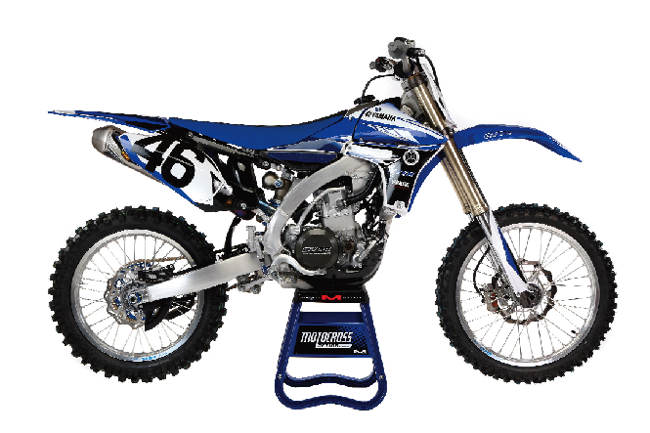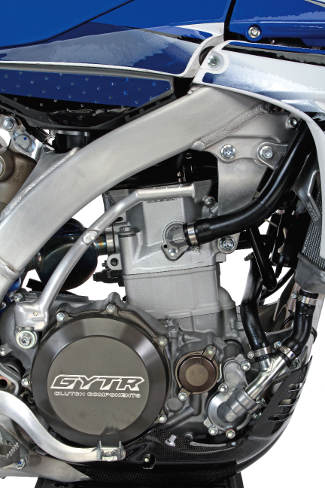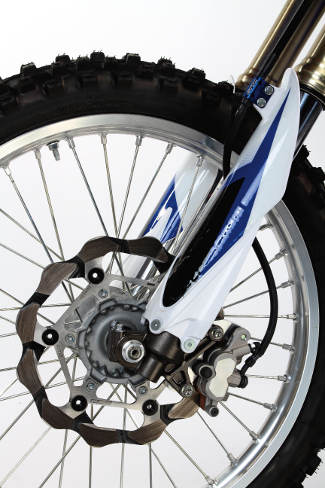WE RIDE A WORKS GYTR YAMAHA YZ450F ENGINE KIT (AND THE REST OF THE BIKE ALSO)

Yamaha used to have a race team to develop hop-up products for their race bikes. The only problem was that when Team Yamaha did the R&D, they kept the results secret. In fact, they hid the data like it was the formula for Coca-Cola. Now there is no Team Yamaha anymore. No trick parts. No secret technology. No in-house Gyro Gearloose tricks. Instead, when Yamaha dropped their factory motocross team, they handed the development of the
YZ-F’s aftermarket components over to GYTR (Genuine Yamaha Technology Racing). GYTR has been around in one form or another for 40 years, but the demise of Team Yamaha was their chance to shine. If Yamaha’s support teams (L&M, Star, JGR and Moto Concepts) want technical support from the Yamaha factory, they are offered the support of GYTR. The GYTR product lineup for the YZ450F includes exhaust pipes, clutches, sprockets, pistons, cams, ported cylinder heads, air filters, engine covers, flywheel weights, sprockets, oversize brakes, chains, and complete wheels.

All GYTR heads are ported precisely the same. There are no variations. You don’t get a head that was ported on Friday afternoon by a grinder who wanted to go home.
Of course, that means that GYTR is in competition with the companies that normally vie to have race teams use their products. But GYTR has one big advantage over other aftermarket companies when developing their accessories: they have access to the Yamaha test department, and GYTR has access to all the bikes they need. Before a GYTR product can be sold, the Yamaha testing department must run it through the same rigorous procedures that they use on their production motorcycles. They hammer the parts at tracks and dyno them on Yamaha’s official race team dyno. The Yamaha test department has a specific testing criteria for every model bike they produce to ensure durability. Whatever their program is, it works. Their four-stroke engines consistently outlast the competition. GYTR based their durability testing and numbers on the same program.

MXA’s GYTR project bike received over $4000 worth of updates without one red cent being spent on the suspension.
The MXA wrecking crew likes to put a lot of testing and dyno time into our product and bike tests, but the Yamaha test department makes us look like pikers. We wanted to start working on our test of the GYTR Yamaha YZ450F almost four months before Yamaha gave us the bike. Every week they would tell us that the bike was almost ready, but that Steve Butler and the R&D crew just needed to run a couple more tests. Then, a week later, they needed a little more time. During this process, the testing department was rejecting prototype parts and having new ones built and the testing would have to start over. We appreciate their thoroughness, but this test was scheduled to appear in four months earlier?it took that long for Yamaha to finalize the settings.
Finally, Yamaha called and said that the product testing was done, the bike was broken in and everything was ready to go. We agreed to meet at Glen Helen with the whole GYTR crew for them to give us the bike…it was reminiscent of a hostage trade.
SHOP TALK: WHAT DID THEY TINKER WITH?
What did the Yamaha testing department take three months to test?
Cylinder head: The GYTR cylinder head comes as a complete unit (with the valve train fully assembled). GYTR starts with a blank casting from the Japanese factory (same as the ones that would appear on a production bike). Then, instead of sending it to a craftsman to port by hand, they program a five-axis CNC machine with their well-tested digital specs. The machine does all the work (and the machine is at the Cosworth factory). This means that all GYTR heads are precisely the same. There are no variations. You don’t get a head that was ported on Friday afternoon by a grinder who wanted to go home.
Camshafts: Most of GYTR’s power delivery tuning was done with cam selection. GYTR narrowed the lobe and timing profiles down to four viable options: from top-end power to bottom-end grunt. The choice was left up to the Yamaha test riders. They chose an aggressive cam (with more lift and duration than the stocker) that fell in the middle of the cam range (for best overall power).
Piston: GYTR was in a quandary when it came to piston selection. To their credit, GYTR had pistons cast to their specs, but were stuck between the choice of a 14:1 compression ratio piston, that was good for more midrange power, and a 13.5:1 piston that was more fuel friendly and more durable. After testing, microscopic examinations and wear tests, GYTR chose the 13.5:1 piston (stock is 13:1). GYTR is very proud of their “single ring” piston (it has one compression ring, but still has the oil rings). The single ring lessens friction.
 |
| GYTR emphasizes durability. This is illustrated by the GYTR billet clutch, 13.5:1 compression ratio and rigorous testing. |
Race gas: Yamaha wanted to make sure that we ran either VP Racing’s MR Pro-5 or U4.4 in the engine, because of the higher compression. We pressed them on the point, because we didn’t see 13.5:1 as a compromising compression ratio for 91-octane pump gas. They waffled a little and said that the engine could live on premium pump gas, but that during testing they had data acquisition information that showed that in sand, mud and big hills, there were temperature spikes that race gas could eliminate. Plus, it added horsepower.
Air filter: We hoped that GYTR had developed some intake mods for Yamaha’s Rubic’s Cube airbox, but all they had was a slightly (if at all) different pancake air filter. DT-1 and Twin Air offer better options than GYTR.
Exhaust: The exhaust side was handled by a GYTR-badged version of the FMF Factory 4.1. It shares the same specs, but has a different decal.
Componentry: After spending a ton of money on making a rocket ship engine, you’re still left with something that looks bone stock. This would be very cool if you wanted to fly under the radar and leave the competition scratching their heads when you pulled away on the uphill. On the other hand, some external aftermarket parts make a race engine look the part. Our GYTR project bike was equipped with a full complement of blue-anodized billet bling, including timing plugs, an oil fill cap, a magnetic drain plug, axle blocks and a rear sprocket. The magnetic drain plugs are actually very functional; it’s kind of scary to see all the bits of metal that come out of an engine. Other cosmetic enhancements included the GYTR gold chain, One Industries graphics and GYTR clutch cover.
Clutch: GYTR mounted their complete clutch assembly, including the basket, inner hub, plates, pressure plate and cover.
Miscellaneous: Other GYTR accessories included on the bike are a rear brake clevis, a Braking Batfly front rotor, Tag slim grips, billet front and rear wheel spacer kits and GYTR’s radiator braces.
Brakes: GYTR sells a 270mm Braking Batfly front rotor. It is an awesome brake, especially when compared to the stock 240mm unit. It complemented the extra power, but did place greater demands on the forks under hard braking.
Caveat: The only GYTR part that the MXA wrecking crew had reservations about was their rear sprocket. Our qualms were based on a failure while running a GYTR sprocket just two weeks before this test. We understand that the GYTR sprocket is designed for lightness?and the lightness comes from eliminating the inner ring that goes against the hub flange. MXA test riders have run this style of sprocket many times in the past, but never again. When the GYTR sprocket broke, it destroyed a sprocket, hub, spokes and a navicular bone.
Product line: Believe it or not, GYTR didn’t throw their entire aftermarket parts catalog at MXA‘s project bike. We would have liked some of it. They have a gripper seat cover, a very trick Brembo radial mount caliper, Talon/Excel wheels, holeshot devices, Cycra plastics and other cool accessories.
TEST RIDE: SOME BIKES SHOULD HAVE SEAT BELTS

Booming with plentiful low-to-mid torque, the GYTR YZ450F would wheelie at will. We almost felt sorry for the guys taking the roost behind us in races.
To make sure that our testing was as accurate, if not as long-running, as Yamaha’s, we didn’t change the stock suspension or setup on the GYTR bike. That allowed us to compare it directly against a box stock YZ450F and not be confused by input from peripheral areas.
We were focused on the engine and its power output. At the first test session, when the GYTR guys were on site, we could see that they were nervous. This was an all-or-nothing test. Not only did the GYTR Yamaha have to be fast, but tractable, usable and manageable.
They didn’t need to worry; this bike romped. It was a solid performing engine that with race gas actually hit 60 horsepower on the dyno, but still allowed the rider to utilize the broad powerband during a race without any awkward bursts of power. Best of all, in deep soil and heavy loam, the GYTR YZ450F engine shoveled through like a Top Fuel bulldozer. Even when a bike makes plenty of power everywhere, it still has to shape the powerband to fill in the stronger and weaker points. The GYTR bike was strong on the bottom and was fastest in the upper midrange. It really wasn’t much of a top-end engine, but no test riders complained about having to shift early to compensate for the typical fuel-injected flat-top feel.
 |
| In more than one way, the GYTR project bike was a beast. Braking’s Batfly helped us get a leash on it. |
Even though the Yamaha testing department had been very exacting in their test regimen, GYTR still had some testing to do. They brought two different VP fuels for us to test. First, we ran MR Pro-5 (AMA Pro-legal top-dollar stuff). Then, we emptied the tank and ran VP U4.4 (VP’s best-selling, best-bang-for-the-buck gas). The Pro-5 was faster and peppier.
Once we selected the best gas, the GYTR engineers broke out their reprogramming tool and asked us to try three custom maps that they had developed for this engine spec when running on VP U4.4. Every map was one or two points richer everywhere and one to four points advanced on the ignition from the mid on up. The “smooth” map was a little richer and one point retarded on the bottom. The “aggressive” map was four points advanced everywhere. The third map was somewhere in between. We didn’t actually have to choose the best map, because the maps could be changed in about 10 seconds with the GYTR Power Tuner. The “smooth” map was better on hardpack tracks, and the “aggressive” map put more power to the ground at the first crack of the throttle.
A faster bike puts more demand on everything, including the suspension. At 60 horsepower, this was a drag-race dream machine. On Glen Helen’s and Cahuilla Creek’s big hills, we could lollygag at the bottom and still blow by other bikes by the top. With all of the extra ponies, perhaps we could have used slightly stiffer suspension. More power will load and spin the rear wheel more during acceleration, putting extra demands on the shock. MXA test riders felt that firmer springs and/or valving were needed to bring the OEM suspension up to speed with the engine.
And, yes, we did run a test session with pump gas. The bike ran fine, but after that we resorted to a 50/50 mix of pump gas and VP.
VERDICT: WHAT’S THE FINAL WORD?
Testing. Yamaha’s and GYTR’s extensive testing yielded big results. The $2000 price tag for the ported head is steep, but this is as close as anyone will ever come to owning a factory Yamaha engine (plus, GYTR includes the head casting, valves and camshafts). For the money, you also get the services of Yamaha’s in-house test riders and sponsored racers.
We spent $4221.84 in total on GYTR parts. It would be foolish for a local schmo to drop this kind of coin in one fell swoop (especially without touching the suspension), but this project bike could be built in stages. Each piece could be ordered to complement your needs and riding style.
For more information, see your friendly local Yamaha dealer or go to www.yamaha-motor.com.





Comments are closed.